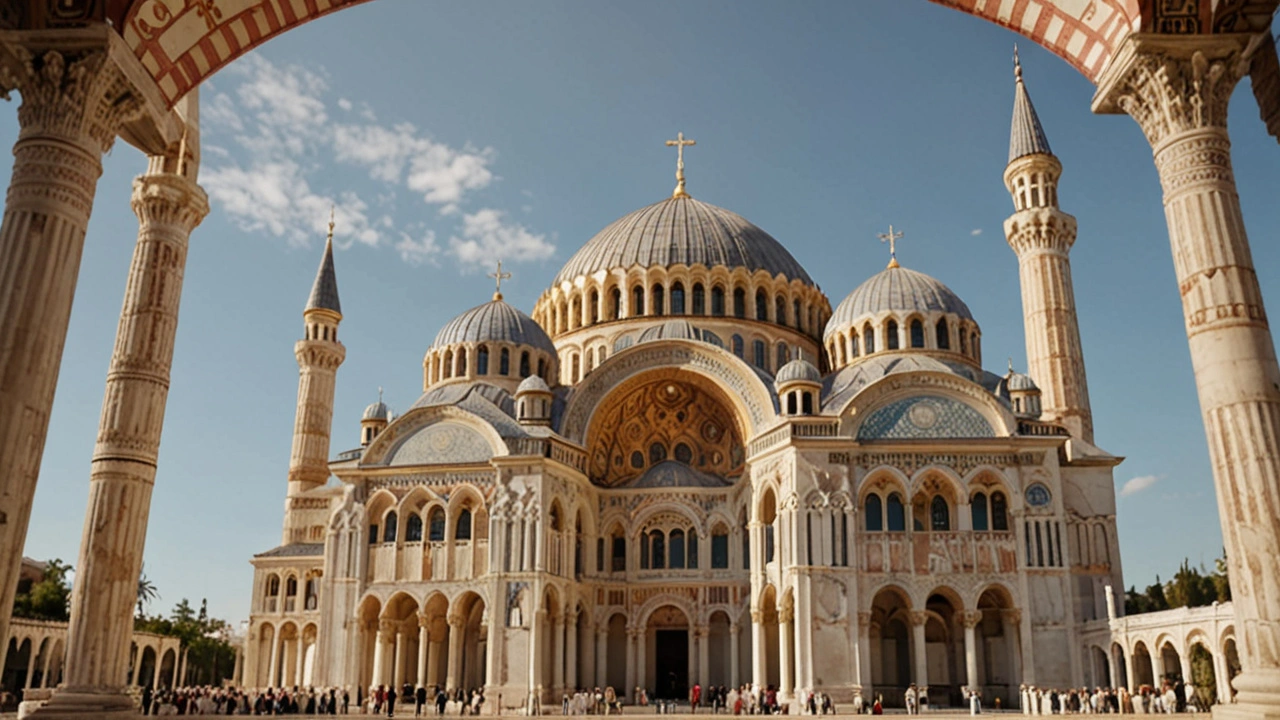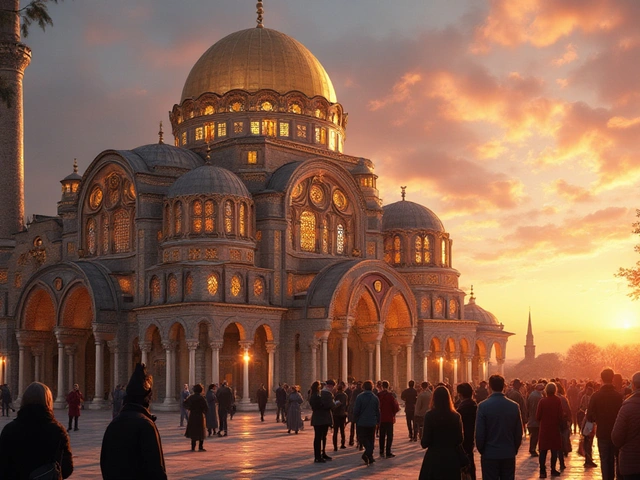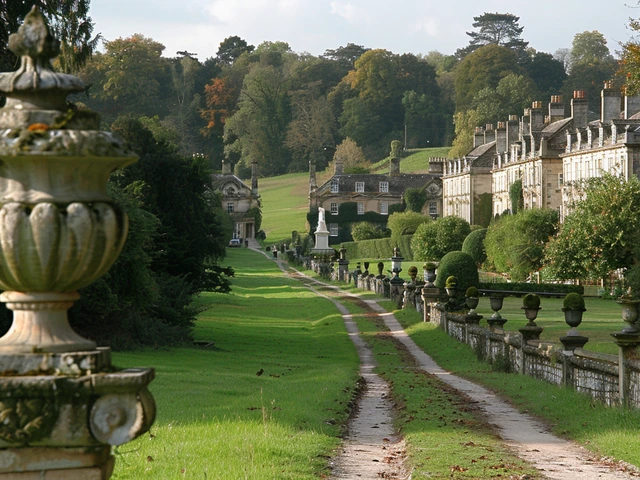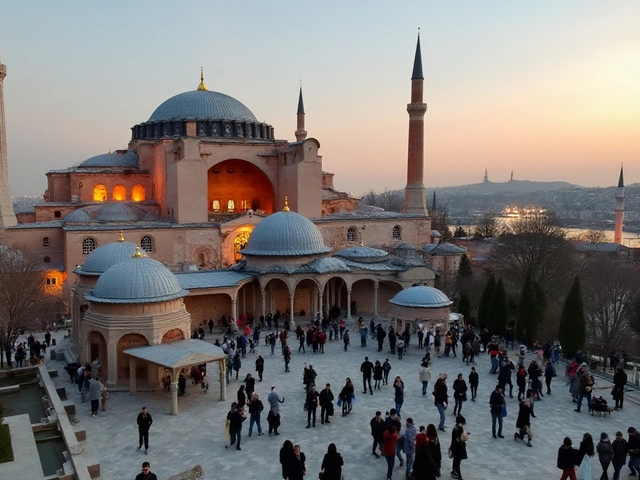Byzantine architecture stands as a testament to the grandeur and opulence of the Byzantine Empire. Evolving from Roman architecture, this unique style thrived between the 4th and 15th centuries, leaving a lasting legacy that continues to influence architectural designs today.
Characterized by its magnificent domes, extensive use of mosaics, and intricate detailing, Byzantine architecture embodies a blend of functional design and artistic expression. This blend created structures that were not only visually stunning but also served as spaces for worship, governance, and social gatherings.
Understanding the history and elements of Byzantine architecture gives a deeper appreciation for its enduring elegance and innovative spirit. Join us as we delve into the captivating world of Byzantine architectural wonders, exploring their origins, distinctive features, and the inspiration they provide for modern architecture enthusiasts.
- Origins of Byzantine Architecture
- Distinctive Features
- Influence on Modern Architecture
- Famous Byzantine Structures
- Practical Tips for Architecture Enthusiasts
Origins of Byzantine Architecture
The story of Byzantine architecture begins in the early 4th century AD with the founding of the Byzantine Empire by Emperor Constantine the Great. He made a pivotal decision to move the Roman capital to Byzantium, later known as Constantinople—modern-day Istanbul. This strategic relocation not only marked a new era for the empire but also set the stage for an architectural revolution.
Much of Byzantine architecture grew out of the Roman architectural traditions. Early Byzantine builders retained the Roman use of arches, columns, and grand structures, but they also incorporated new elements. One of the most significant innovations was the extensive use of the dome. The famed Hagia Sophia, constructed under Emperor Justinian I between 532 and 537 AD, epitomizes this groundbreaking feature. Its central dome, once considered an engineering marvel, revolutionized the way spaces were designed in religious buildings.
The influence of Christianity played a crucial role in shaping Byzantine architecture. Unlike their Roman predecessors who often built polytheistic temples, the Byzantines focused on creating churches that could accommodate large congregations for Christian worship. This shift gave rise to the basilica plan and centrally planned structures which became the hallmark of Byzantine religious architecture.
One architectural scholar noted, "The transition from the horizontal emphasis of classical to the vertical emphasis of Byzantine architecture symbolizes the shift in the cosmic vision of man’s place in the universe."
Another foundational aspect of Byzantine architecture was the use of intricate mosaics. These colorful and highly detailed pictures made from small pieces of glass and stone often adorned the walls and ceilings of Byzantine churches. They did more than just decorate; they conveyed religious stories and themes to an often-illiterate populace, serving as a visual Bible. The tradition of mosaic artistry continues to be one of the most recognized features of Byzantine influence in architectural decoration.
Byzantine architects also embraced and incorporated elements from neighboring cultures, including Persian and Greek architectural styles. This synthesis of different cultural influences created a unique and enduring architectural style that would be emulated and adapted by regions under Byzantine influence, such as Italy, the Eastern Mediterranean, and Russia.
As the Byzantine Empire expanded and contracted over the centuries, its architectural style evolved but always retained core elements such as the central dome, extensive use of mosaics, and the integration of religious themes. These characteristics helped to ensure that Byzantine architecture would maintain its influence long after the empire's fall in 1453 AD.
Understanding the origins of Byzantine architecture provides significant insights into the ingenuity and creativity that defined this remarkable era. If you stroll through Istanbul or visit historical sites in Ravenna or Venice, the echoes of this architectural brilliance are still visible and continue to inspire architects worldwide.
Distinctive Features
Byzantine architecture is renowned for its unique characteristics that set it apart from earlier and later styles. One of the most recognizable features is the use of large domes that dominate the skyline. These domes, often set on a square base, were a significant engineering achievement and became a staple in Byzantine structures. The Hagia Sophia in Istanbul, with its massive dome, is a prime example. The dome of the Hagia Sophia has a diameter of over 31 meters, showcasing the impressive capabilities of Byzantine engineers and architects.
Another hallmark of Byzantine design is the extensive use of mosaics. These mosaics often depicted religious scenes, figures, and symbols, using tiny pieces of colored glass, stone, or other materials. The interiors of Byzantine churches, such as the Church of San Vitale in Ravenna, Italy, are adorned with these intricate artworks. They not only added color and beauty but also conveyed theological messages to worshippers and visitors.
The architectural layout of Byzantine buildings often revolved around a central plan. This central plan, usually in the form of a Greek cross, emphasized a large, open interior space that was meant to inspire awe and reverence. The layout allowed for easier movement and better acoustics during religious ceremonies. One fascinating feature was the use of pendentives and squinches, which are architectural solutions to place a circular dome over a square room, showcasing the ingenuity and creativity of Byzantine architects.
Byzantine architects paid great attention to the lighting within their structures. Windows were strategically positioned to allow light to pour in and illuminate the interiors, particularly the mosaics. This play of light created an ethereal and spiritual atmosphere that was intended to elevate the soul. The clever use of natural light is evident in many structures, with light entering through clerestory windows and reflecting off the glittering mosaics to produce a mesmerizing effect.
Materials used in Byzantine architecture were often locally sourced, but they didn't shy away from importing luxurious materials when possible. Marble was a common element, with walls and floors often covered in intricate patterns. Precious metals and stones were also used, particularly in mosaics and other decorative elements. The opulence was meant to reflect the glory of the divine and the power of the Byzantine Empire.
An interesting aspect of Byzantine architecture is its iconography. Religious icons were a significant part of Byzantine worship and decoration. These icons were believed to have a spiritual presence and were used both in public worship spaces and private homes. The careful placement and veneration of these icons was a distinctive feature and played an essential role in the daily lives of the Byzantines. As noted by art historian John Beckwith, "The icon was, in the life of the Byzantine Church, what the art of the catacombs had been for the religion of the first Christians."
Overall, the distinctive features of Byzantine architecture not only highlight the technical prowess and artistic creativity of the period but also reflect the cultural and spiritual ethos of the Byzantine Empire. Each element, from the grand domes to the intricate mosaics, came together to create spaces that were both functional and deeply inspiring.

Influence on Modern Architecture
Byzantine architecture has had a substantial impact on modern architectural styles, inspiring countless designers and architects with its unique blend of function and beauty. One of the most notable features adapted into contemporary designs is the deployment of domes. The Hagia Sophia, with its grand central dome, serves as a classic example. Many modern structures, including prominent government buildings and churches around the world, have incorporated dome designs to convey a sense of grandeur and significance.
The extensive use of mosaic art in Byzantine architecture has also found a new home in various modern forms. Today, mosaics are not only used for religious and historical murals but also feature in public art installations, decorative pieces in home interiors, and even commercial spaces. The rich, detailed patterns and vibrant colors can turn any surface into a piece of art, demonstrating the timeless appeal of this technique.
Another significant aspect is the architectural approach to space and light. Byzantine buildings often utilized large windows and open layouts, designed to allow natural light to enhance the interior's beauty. This principle is echoed in modern architecture, especially in the works of designers who prioritize sustainable and green building practices. The idea of creating spaces that are not only functional but also harmonious with nature can be attributed in part to the far-reaching influence of Byzantine architectural principles.
"The Byzantine style presents a fascinating dichotomy of robust structural engineering and intricate aesthetic details, a combination that continues to captivate modern architects." - Dr. Elena Peters, Architectural Historian
Modern architects also draw inspiration from the symbolic and liturgical aspects of Byzantine architecture. The intentional use of certain materials, colors, and structures to convey spiritual and philosophical meanings has made its way into contemporary designs. This is evident in buildings meant to serve as places of sanctuary, learning, or community gathering, where the design aims to foster an environment of reflection and connection.
Moreover, the aesthetic of arches and columns, which were prominent in Byzantine designs, continues to be a popular element in modern architecture. These features are not just visually appealing but also serve structural functions, providing support and stability. The blend of beauty and utility remains a guiding principle for many architects today.
Byzantine architecture has left an indelible mark on the world, influencing not only how structures are built but also how spaces are conceptualized. Its elements have been re-imagined and reinterpreted across various cultures and time periods, demonstrating that good design truly stands the test of time.
Famous Byzantine Structures
Byzantine architecture flourished for over a millennium, producing a wealth of famous structures that still stand today as marvels of engineering and beauty. One of the most iconic examples is the Hagia Sophia in Istanbul, Turkey. Originally constructed as a cathedral in 537 AD by Emperor Justinian I, it was the world's largest building and an engineering marvel of its time. Its massive dome, supported by pendentives, creates a vast interior space that seems almost ethereal. The Hagia Sophia’s interior walls are adorned with intricate mosaics, many depicting Christian iconography, though layers of history have seen it transition from a cathedral to a mosque, and now a museum.
Another significant structure is the Church of San Vitale in Ravenna, Italy, built in the 6th century. Unlike traditional basilicas, it features an octagonal plan and is renowned for its vibrant mosaics, including famous depictions of Emperor Justinian and Empress Theodora. The artistry and craftsmanship evident in these mosaics convey a wealth of historical and cultural information, serving as a testament to the prosperity and artistic prowess of the Byzantine Empire.
The Monastery of Hosios Loukas in Greece is also notable. Constructed in the 10th century, it exemplifies middle Byzantine architecture. Its Katholikon, or main church, combines the classic cross-in-square plan with elaborate brickwork and intricate interior mosaics. Such structures highlight the way Byzantine architects used brick and stone not just for structural purposes but also as decorative elements.
Beyond these, the Palace of the Porphyrogenitus in Istanbul stands as one of the best-preserved examples of Byzantine palace architecture. Despite the ravages of time and numerous political upheavals, parts of the original structure still showcase the opulence once enjoyed by Byzantine royalty. The palace’s walls are adorned with intricate frescoes and marble carvings, reflecting the high level of artistic achievement during the height of the Byzantine Empire.
Also worthy of mention is the Church of the Holy Apostles in Thessaloniki, Greece, constructed in the late 14th century. This church’s harmonious blend of brick and stone, along with its extensive use of decorative ceramic elements, represents a mature phase of Byzantine architecture. Its frescoes and intricate iconostasis are considered masterpieces of Byzantine art.
In the words of architectural historian Robert Ousterhout,
“Byzantine architecture was more than just a building style; it was an expression of the empire's ideology and its vision of the heavenly kingdom on earth.”This sentiment captures the essence of why these structures continue to captivate and inspire. They are not merely buildings but rather enduring symbols of a civilization that left a profound impact on the world of architecture.
These famous Byzantine structures, among many others, offer a window into the past, allowing us to appreciate the intricate designs and innovative techniques that characterized Byzantine architecture. For anyone interested in historical architecture or simply in awe of human creativity, these monumental edifices are a must-see, providing endless inspiration and deepening our understanding of an ancient yet enduring legacy.
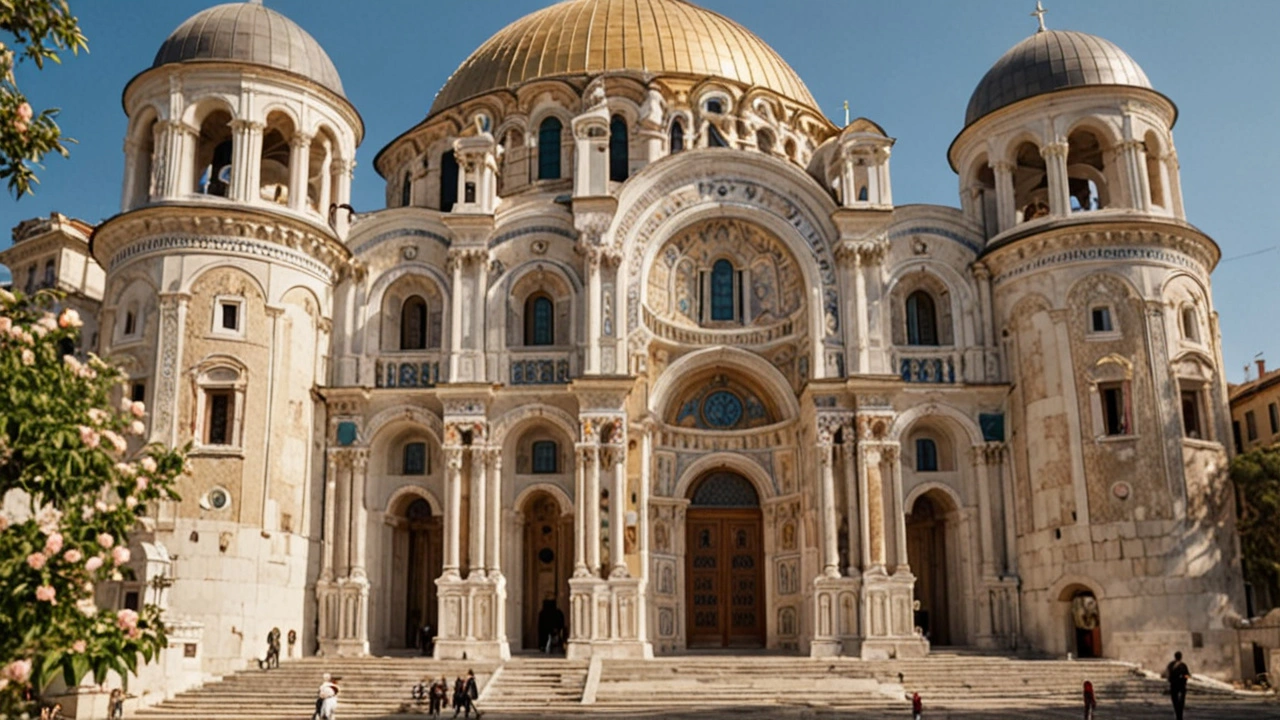
Practical Tips for Architecture Enthusiasts
Immersing yourself in the world of Byzantine architecture can be a thrilling experience whether you're an aspiring architect or a seasoned enthusiast. One effective way to start is by studying its historical context. Understanding the socio-political environment of the Byzantine Empire gives a deeper perspective on why certain architectural choices were made. This background knowledge informs your appreciation and interpretation of the structures.
Visiting iconic Byzantine sites can significantly enhance your learning experience. Seeing the Hagia Sophia in Istanbul or the Church of San Vitale in Ravenna up close allows you to observe the details and craftsmanship that photographs often miss. When visiting such sites, take extensive notes and sketches. Pay particular attention to the use of space, light, and ornamentation. This hands-on exploration can inspire and inform your own design projects.
Dive into the technical aspects as well. Byzantine architecture is renowned for its innovative use of domes and arches. For aspiring builders, mastering these structural techniques can be incredibly rewarding. Engage with architectural drawings, blueprints, and models to better understand how these elements come together. Studying these components can improve your ability to create balanced and aesthetically pleasing designs.
Contemporary architects continue to draw inspiration from Byzantine principles. Many modern designs incorporate elements like geometric patterns, central dome structures, and extensive mosaic art. By analyzing contemporary structures influenced by Byzantine design, you can identify practical ways to integrate historical elements into modern projects. This fusion of old and new can result in unique and innovative architectural solutions.
Reading specialized literature and attending workshops or lectures can further deepen your expertise. Seek out texts written by leading scholars and practitioners in the field.
As Norman Foster once noted, "Architecture is an expression of values." Studying Byzantine architecture reveals the values of its time, such as the importance of community, spirituality, and artistic expression.Participating in seminars and discussions can also help you stay updated on the latest research and trends in the field.
Joining architecture-focused groups or clubs can provide a supportive community of like-minded individuals. These groups often organize trips, discussions, and collaborative projects that can enrich your understanding and appreciation of Byzantine architecture. Sharing insights and learning from others can enhance your overall experience and knowledge.
Finally, don't be afraid to experiment in your own designs. Try incorporating Byzantine elements in your projects, even in subtle ways. Whether it's the use of a particular type of mosaic or the incorporation of a domed ceiling, these elements can add depth and richness to your work. Experimentation fuels creativity and can lead to breakthroughs in your architectural practice.
| Tip | Action |
|---|---|
| Study Historical Context | Research the Byzantine Empire's socio-political background |
| Visit Iconic Sites | Observe and document firsthand details and craftsmanship |
| Master Structural Techniques | Engage with architectural drawings, blueprints, and models |
| Analyze Contemporary Designs | Identify how Byzantine elements are used in modern projects |
| Read Specialized Literature | Seek out texts by leading scholars and practitioners |

